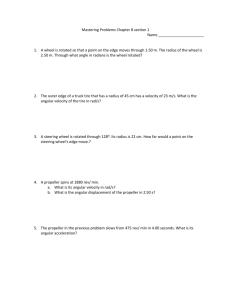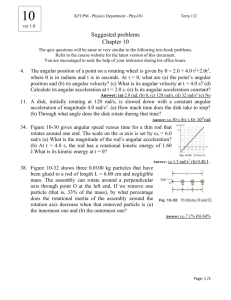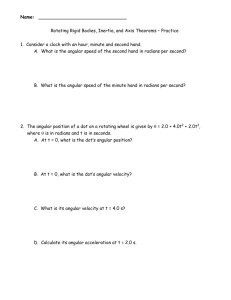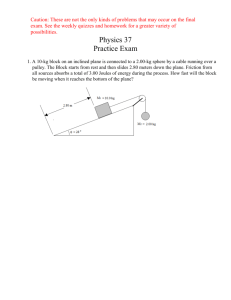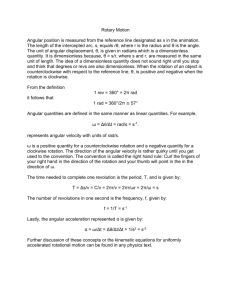Rotary Homework #1:
advertisement
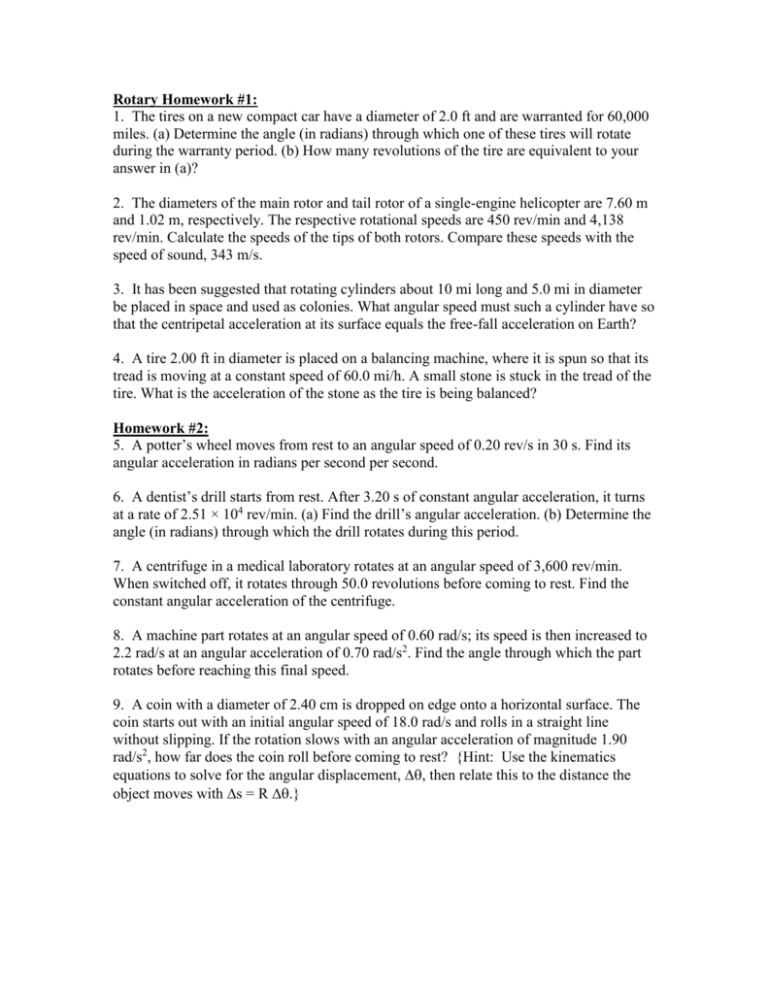
Rotary Homework #1:
1. The tires on a new compact car have a diameter of 2.0 ft and are warranted for 60,000
miles. (a) Determine the angle (in radians) through which one of these tires will rotate
during the warranty period. (b) How many revolutions of the tire are equivalent to your
answer in (a)?
2. The diameters of the main rotor and tail rotor of a single-engine helicopter are 7.60 m
and 1.02 m, respectively. The respective rotational speeds are 450 rev/min and 4,138
rev/min. Calculate the speeds of the tips of both rotors. Compare these speeds with the
speed of sound, 343 m/s.
3. It has been suggested that rotating cylinders about 10 mi long and 5.0 mi in diameter
be placed in space and used as colonies. What angular speed must such a cylinder have so
that the centripetal acceleration at its surface equals the free-fall acceleration on Earth?
4. A tire 2.00 ft in diameter is placed on a balancing machine, where it is spun so that its
tread is moving at a constant speed of 60.0 mi/h. A small stone is stuck in the tread of the
tire. What is the acceleration of the stone as the tire is being balanced?
Homework #2:
5. A potter’s wheel moves from rest to an angular speed of 0.20 rev/s in 30 s. Find its
angular acceleration in radians per second per second.
6. A dentist’s drill starts from rest. After 3.20 s of constant angular acceleration, it turns
at a rate of 2.51 × 104 rev/min. (a) Find the drill’s angular acceleration. (b) Determine the
angle (in radians) through which the drill rotates during this period.
7. A centrifuge in a medical laboratory rotates at an angular speed of 3,600 rev/min.
When switched off, it rotates through 50.0 revolutions before coming to rest. Find the
constant angular acceleration of the centrifuge.
8. A machine part rotates at an angular speed of 0.60 rad/s; its speed is then increased to
2.2 rad/s at an angular acceleration of 0.70 rad/s2. Find the angle through which the part
rotates before reaching this final speed.
9. A coin with a diameter of 2.40 cm is dropped on edge onto a horizontal surface. The
coin starts out with an initial angular speed of 18.0 rad/s and rolls in a straight line
without slipping. If the rotation slows with an angular acceleration of magnitude 1.90
rad/s2, how far does the coin roll before coming to rest? {Hint: Use the kinematics
equations to solve for the angular displacement, , then relate this to the distance the
object moves with s = R.}
Homework #3:
10. A sample of blood is placed in a centrifuge of radius 15.0 cm. The mass of a red blood cell is 3.0 × 10 –
16
kg, and the magnitude of the force acting on it as it settles out of the plasma is 4.0 × 10–11 N. At how
many revolutions per second should the centrifuge be operated?
11. A certain light truck can go around a flat curve having a radius of 150 m with a maximum speed of
32.0 m/s. With what maximum speed can it go around a curve having a radius of 75.0 m? {Hint: Assume
the same centripetal acceleration for each case.}
12. A 55.0-kg ice-skater is moving at 4.00 m/s when she grabs the loose end of a rope, the opposite end of
which is tied to a pole. She then moves in a circle of radius 0.800 m around the pole. (a) Determine the
force exerted by the horizontal rope on her arms.
(b) Compare this force with her weight.
13. A race car starts from rest on a circular track of radius 400 m. The car’s speed increases at the constant
rate of 0.500 m/s2. At the point where the magnitudes of the centripetal and tangential accelerations are
equal, determine (a) the speed of the race car, (b) the distance traveled, and (c) the elapsed time.
14. A 50.0-kg child stands at the rim of a merry-go-round of radius 2.00 m, rotating with an angular speed
of 3.00 rad/s. (a) What is the child’s centripetal acceleration? (b) What is the minimum force between her
feet and the floor of the carousel that is required to keep her in the circular path? (c) What minimum
coefficient of static friction is required? Is the answer you found reasonable? In other words, is she likely to
stay on the merry-go-round?
15. An engineer wishes to design a curved exit ramp for a toll road in such a way that a car will not have to
rely on friction to round the curve without skidding. He does so by banking the road in such a way that the
force causing the centripetal acceleration will be supplied by the component of the normal force toward the
center of the circular path. (a) Show that, for a given speed v and a radius r, the curve must be banked at the
angle θ such that tan θ = v2/rg. (b) Find the angle at which the curve should be banked if a typical car
rounds it at a 50.0-m radius and a speed of 13.4 m/s.
16. An air puck of mass 0.25 kg is tied to a string and allowed to revolve in a circle of radius 1.0 m on a
frictionless horizontal table. The other end of the string passes through a hole in the center of the table, and
a mass of 1.0 kg is tied to it (figure below left). The suspended mass remains in equilibrium while the puck
on the tabletop revolves. (a) What is the tension in the string? (b) What is the horizontal force acting on the
puck? (c) What is the speed of the puck?
17. In a popular amusement park ride, a rotating cylinder of radius 3.00 m is set in
rotation at an angular speed of 5.00 rad/s, as in the figure above right. The floor then
drops away, leaving the riders suspended against the wall in a vertical position. What
minimum coefficient of friction between a rider’s clothing and the wall is needed to keep the rider
from slipping? (Hint: Recall that the magnitude of the maximum force of static friction is equal
to μn, where n is the normal force—in this case, the force causing the centripetal acceleration.)
Solutions:
1.
(a)
s 60000 m i 5280 ft
8
3.2 10 rad
r
1.0 ft
1m i
1 rev
3.2 108 rad
5.0 107 rev
2
r
ad
rev 2 rad 1 m in
Main Rotor: v r 3.80 m 450
179 m s
m in 1 rev 60 s
(b)
2.
m vsound
v = 179
= 0.522vsound
s 343 m s
Tail Rotor:
rev 2 rad 1 m in
v r 0.510 m 4138
221 m s
m in 1 rev 60 s
m v
v = 221 sound = 0.644vsound
s 343 m s
3.
The radius of the cylinder is r 2.5 m i
1609 m
4.0 103 m . Thus, from
1 m i
ac r 2 , the required angular velocity is
ac
r
9.80 m s2
4.9 10-2 rad s
3
4.0 10 m
4.
Since the tire rotates at constant speed, the tangential acceleration of the stone is
zero. Thus, its only acceleration is the centripetal acceleration given by
2
5.
m i 0.447 m s
60.0
2
h 1 m ih
vt
ac
2.36 103 m s2
1
m
r
1 ft
3.281 ft
f i
We use
and find
t
0.20 rev s 0 2 rad
-2
2
4.2 10 rad s
30 s
1 rev
2.51 10
(a)
rev m in 0 2 rad 1 m in
2
821 rad s
3.20 s
1 rev
60.0 s
4
6.
1
1
rad
2
(b) it t2 0 821 2 3.20 s 4.21 103 rad
2
2
s
7.
i 3600
rev 2 rad 1 m in
377 rad s
m in 1 rev 60.0 s
2 rad
50.0 rev
314 rad
1 rev
w i2 0 377 rad s
226 rad s2
Thus,
2
2 314 rad
2
8.
From 2 i2 2 , the angular displacement is
2 i2 2.2 rad s 0.60 rad s
3.2 rad
2
2 0.70 rad s2
2
9.
2
The angular displacement of the coin while stopping is
2f i2
2
0 18.0 rad s
2 1.90 rad s2
2
85.3 rad
The linear displacement is s r with r diam eter 2 1.20 cm , or
s 1.20 cm
10. Since Fc m
=
85.3 rad 102 cm
1.02 m
vt2
m r 2 , the needed angular velocity is
r
Fc
=
mr
4.0 1011 N
3.0 1016 kg 0.150 m
1 rev
= 9.4 102 rad s
= 1.5 102 rev s
2
r
ad
11.
Friction between the tires and the roadway is capable of giving the truck a
maximum centripetal acceleration of
ac,m ax
vt2,m ax
r
32.0 m s
150 m
2
6.83 m s2
If the radius of the curve changes to 75.0 m, the maximum safe speed will be
vt,m ax rac,m ax
75.0 m 6.83 m
s2 22.6 m s
12.
(a) From Fr m ac , we have
v2 55.0 kg 4.00 m s
T m t
1.10 103 N 1.10 kN
0.800 m
r
2
The tension is larger than her weight by a factor of
(b)
T
1.10 103 N
2.04 tim es
m g 55.0 kg 9.80 m s2
13.
(a) The centripetal acceleration is ac
vt2
. Thus, when ac at 0.500 m s2 , we
r
have
vt rac
400 m 0.500 m s2 200 m s 14.1 m s
(b) At this time, t
200 m s 0
vt vi
28.3 s, and the linear displacement
at
0.500 m s2
is
v v 200 m s 0
s vt av t t i t
28.3 s 200 m
2
2
The time is t 28.3 s as found in part (b) above.
(c)
14.
(a)
ac r 2 2.00 m
3.00 rad s
2
18.0 m s2
(b) Fc m ac 50.0 kg 18.0 m s2 900 N
(c)
We know the centripetal acceleration is produced by the force of friction.
Therefore, the needed static friction force is fs 900 N . Also, the normal force is
n m g 490 N . Thus, the minimum coefficient of friction required is
s
f
s m ax
n
900 N
= 1.84
490 N
So large a coefficient of friction is unreasonable, and she will not be able to stay on the
merry-go-round.
15.
(a) From Fy 0 , we have
n cos m g
(1)
where n is the normal force exerted on the car by
the ramp.
Now, require that, Fradialinw ard m ac , or
n sin m
vt2
r
(2)
tan
Divide (2) by (1) to obtain
vt2
rg
(b) If r = 50.0 m and vt 13.4 m s, the needed bank angle is
2
13.4 m s
tan
50.0 m 9.80 m
1
16.
2
20.1
(a) Since the 1.0-kg mass is in equilibrium, the tension in the string is
T m g 1.0 kg 9.8 m s2 9.8 N
(b) The tension in the string must produce the centripetal acceleration of the
puck. Hence, Fc T 9.8 N .
(c)
vt2
, we find vt
r
From Fc m puck
rFc
m puck
1.0 m 9.8 N
0.25 kg
6.3 m s
17.
The normal force exerted on the person by the cylindrical wall must provide the
centripetal acceleration, so n m r 2 .
If the minimum acceptable coefficient of friction is present, the person is on the verge of
slipping and the maximum static friction force equals the person’s weight, or
fs m ax s m in n m g
Thus, s m in
mg
g
9.80 m s2
0.131
n
r 2 3.00 m 5.00 rad s2



